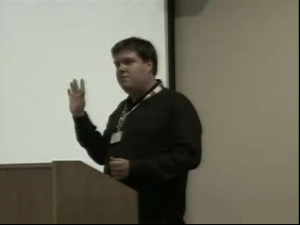Session Summary: Mobile Web and Campus Assistant
12:50 pm in plenaries by kirsty-pitkin
 Damian Steer from the University of Bristol provided us with an overview of the evolution of the mobile web, including the development of the hardware capabilities and the mobile web protocols through from WAP to WML.
Damian Steer from the University of Bristol provided us with an overview of the evolution of the mobile web, including the development of the hardware capabilities and the mobile web protocols through from WAP to WML.
Steer identified 2000 as the year that things started to get interesting, when lots of people had mobile devices and they started to be used for purposes other than voice calls – including SMS messaging. At this point, phones start to become internet devices, but are very much “leafs on the network”. They didn’t speak the same language as the rest of the internet, which enabled service providers to offer a walled garden service. The devices themselves were also very restricted – Steer noted that he has icons bigger than some of the mobile screens from that period. As a result, not many people were making use of these limited internet services.
Things improve from 2002 onwards, when smart phones appear. These start to have bluetooth, GPS and cameras, as well as internet connectivity and email so these devices were starting to look more like proper web devices, using Java and XHTML. At this point Steer drew particular attention to Opera Mini, which was not widely used, but deserved appreciation because it handled the real web very well. It allowed you to look at normal web pages on a reasonably limited device without any need for the pages to be specially configured.
Steer then moved on to 2007 and the advent of the iPhone, which he noted had almost no novel features at all, except for gestures, but was very useable. He demonstrated the iPhone effect by showing us the increase in mobile users visitors to the University of Bristol website. The proportion of these visitors using an Apple product is much higher than Apple’s market share, showing that whilst many devices had the capacity to enable web browsing, people were not making use of these features as much. Steer used this point to illustrate how there is no equivalent to I.E 6 in the mobile web sphere – there are terrible browsers out there, but people are not using them, so there is no need to cater for them.
In response to the question “how does my institution join the mobile web?”, Steer noted that if universities are building websites that comply with web standards, don’t use Flash too much, and stick to good practice with regards to accessibility, then their websites already work on a mobile device. He also noted that the proportion of people accessing university sites from a mobile device is still very small, so there needs to be some perspective. He also recommended thinking about the context – the situations when your users will only have a mobile device conveniently available and what services will they require at those points? He also discussed the benefits of building mobile web applications, rather than native applications in terms of market coverage and support. He explained how CSS can be used to tune your mobile website to suit the capabilities of a range of devices if you don’t want to build a specialised mobile page. Specialised mobile sites often have limited functionality, but can make use of some of the features of the device, such as the GPS to offer different services. However, browser sniffing and redirecting to mobile sites is generally frowned upon.
This led Steer to describe the University of Bristol Campus Assistant, which was a JISC Rapid Innovation project. This was designed to be a time and location sensitive service for students, rather than a complete mobile version of the University of Bristol site. The use cases included: location of the nearest wireless spot; location of a free PC to use; times of buses to halls of residence; library opening times. The bus departures feature is the most popular feature. The Campus Assistant takes information from RSS feeds, screen scrapes from web pages and other sources, and represents this in a relevant way. It is an open source and ongoing project, so it can be reused if you can provide the information to feed into it.
Steer then handed over to Alex Dutton, who described a similar project undertaken by the Oxford University, called Mobile Oxford. Again, this presents essentials such as bus information, feeds from local webcams, locations of pubs and university buildings. The main features he discussed were the contacts search and the library search for which they use a Google search client to index the site and provide the XML to help people search the site. Dutton’s favourite aspect of the project is that although it is a mobile web app, they have left it open for people to build other web apps or native applications on top, as each page can be rendered in HTML, XML, JSON or YAML. Future developments include linking into their VLE and other authenticated services. Dutton also explained how this project has now been taken open source to become the Molly project, which they hope will enable it be used at other universities too.
Damian Steer’s slides are available at Slideshare here.
0 Responses to Session Summary: Mobile Web and Campus Assistant